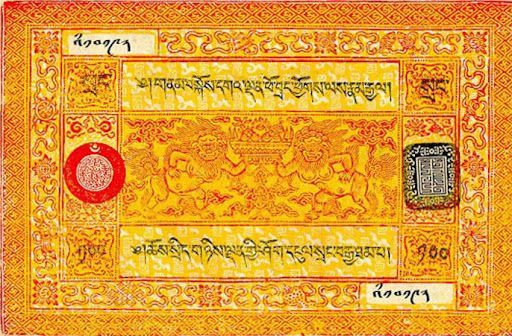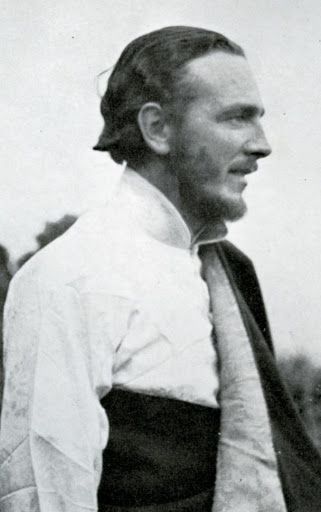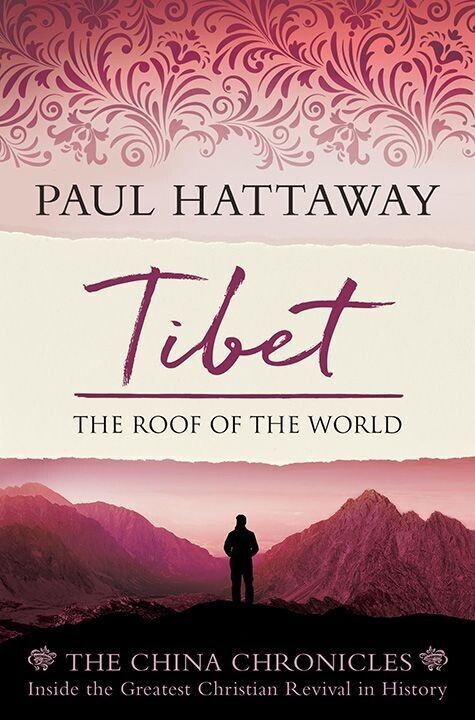1950s
Ü-Tsang དབུས་གཙང་

Tibetan dreams of becoming an independent nation came crashing down in the 1950s, as massive upheavals struck every part of Tibetan society, and hundreds of thousands of people were mercilessly slaughtered by the Communists.
Between 1913 and 1950, the Tibetan government in Lhasa had tried to assert its authority as a separate country, issuing its own flag, passports and currency. A Tibetan stamp was printed in India, bearing the image of the Dalai Lama, although as one source pointed out, "These were rejected by the Tibetans.... The Dalai Lama could not be placed on a stamp as it might get trodden underfoot, which would bring dishonor to him. Besides, who was going to strike his head with a great metal franking hammer?".
Life in Tibet experienced a sudden and dramatic shift after a Chinese general declared in 1951: "Efforts must be made to raise the population of Tibet from two million to more than ten million." This new policy was to be implemented by waves of Han Chinese migrants moving to the Tibetan Plateau. Unsurprisingly, the Tibetans were alarmed and indignant when they heard about the new initiative.
Christians with a burden to reach Tibet were divided in their views of the Chinese takeover of the land. While some lamented the influence the atheistic regime would have on the Tibetan people, others looked through eyes of faith and saw an opportunity for the gospel to knock down the iron gates that had kept Tibet firmly shut off to Christianity for centuries. Missionary Edward Beatty wrote in December 1950:
"Today the armies of Communist workmen are building a motor road across Tibet on which ten-wheel trucks already are moving toward Tibet's capital, Lhasa. We believe, hope and pray that this road, in the wisdom and power of God, will become a way of advance for those who proclaim the Christian gospel and way of life.
But will Western Christians be permitted to enter in? So long as the Lord has need of them, He will enable His chosen ones to enter the land. In Chinese Tibet we one day listened spellbound to a small group of recently arrived Chinese Christians thanking God that He had reserved Tibet as a special field of service for the Chinese Church."
George Patterson

One of the most controversial of all missionaries among the Tibetan people was George Patterson, a Brethren believer from Scotland. He lived in the Kham region from 1947 to 1952, siding with the Khampas in their struggle for survival against both the Chinese army and other Tibetan factions. Instead of simply preaching the gospel to the Tibetans, Patterson soon found himself caught up in a complex situation. One historian explained:
"He hoped to gain a political and military victory over both the reactionary government in Lhasa, and the approaching armies of the People's Republic of China. Such a strategy, deplored by most of his missionary colleagues in Kangding, would produce justice for the Tibetans, he claimed. Furthermore, he thought it would enable him as a missionary to develop a new foundation for Tibetan culture, one that would have the gospel as an essential ingredient. The plan did not work."
Many in the mission world were aghast as Patterson plunged into the murky world of political intrigue. Fully convinced he was on the right path, he even persuaded Khampa warriors to take him along so that he could film an ambush where they massacred a group of Chinese soldiers.
Further controversy followed when Patterson helped the Dalai Lama to flee Tibet in 1959. This act convinced many missionaries that Patterson had fallen into deception, a view that was only reinforced by his own testimony, in which he claimed to have come to Asia after hearing an audible voice in his home country, telling him to go to Tibet. Patterson admitted: "I knew nothing about Tibet, except that it was a remote country with unusual customs. But I was intrigued enough to begin reading about Tibet, and to begin a personal dialogue with God on the basis that he was the one who had spoken to me."
George Patterson helped the Dalai Lama to flee to India just before the Chinese forces arrived in Lhasa with plans to either capture or kill the Tibetan leader. The successful escape caused great celebration among Tibetans, and has sustained the cause of Tibetan Buddhism to the present day.
Many Christians, understandably, have questioned the wisdom of a professing missionary helping the survival of a man considered by millions of Tibetans to be a Living God, but Patterson, as always, remained unapologetic, saying he was doing God's will and would have no hesitation in doing so again.
Patterson also fled to India, and then later returned home to Scotland. Until his death in 2012 at the age of 92, he "continued to press for Tibetan rights before international bodies, with full assurance that it was God's will. Tibetan leaders outside of China, including the Dalai Lama, have indicated that Patterson has been a better friend to them than the United States, Great Britain, or India."
© This article is an extract from Paul Hattaway's book ‘Tibet: The Roof of the World’. You can order this or any of The China Chronicles books and e-books from our online bookstore.
1.Buckley and Strauss, Tibet: a Travel Survival Kit, p. 25
2. E. E. Beatty, "Tibet: a Notable Observation," China's Millions (December 1950), p. 126.
3. Covell, The Liberating Gospel in China, pp. 79-80.
4. See George N. Patterson, Patterson of Tibet: Death Throes of a Nation (San Diego, CA: ProMotion Publishing, 1998), p. 383.
5. "How God Helped Save the Dalai Lama of Tibet," Assist News Service (January 1, 2001).
6. Covell,
The Liberating Gospel in China, p. 80.





